

Mainstreaming vs. Inclusion in Special Education: What’s the Difference? Written by: Keren Perles • edited by: Elizabeth Wistrom • updated: 3/6/2012 Mainstreaming and inclusion can seem very similar to each other, and are in fact often used interchangeably.
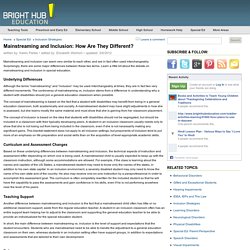
Surprisingly, there are some major differences between these two terms. Learn a little bit about the debate on mainstreaming and inclusion in special education. Section 504 and Deaf and Hard of Hearing Children in Public Preschool, Elementary and Secondary Schools. Many deaf education professionals and parents of deaf children are familiar with the Individuals with Disabilities Education Act (IDEA).
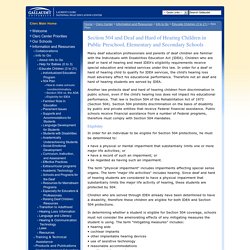
Children who are deaf or hard of hearing and meet IDEA's eligibility requirements receive special education and related services under this law. In order for a deaf or hard of hearing child to qualify for IDEA services, the child's hearing loss must adversely affect his educational performance. Therefore not all deaf and hard of hearing students are served by IDEA.
Another law protects deaf and hard of hearing children from discrimination in public school, even if the child's hearing loss does not impact his educational performance. That law is Section 504 of the Rehabilitation Act of 1973 (Section 504). Early Intervention for Deaf Children. Marion schools among leaders in inclusion efforts for deaf students. Aided with a cochlear implant — a hearing device surgically placed in the head of a deaf person to give him some sense of hearing — Jarrod used sign language to answer questions about school life.
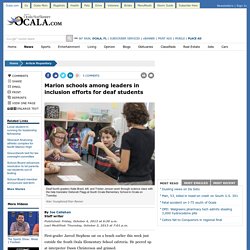
Jarrod loves his first-grade teacher, Maggie McCraw. His favorite subject is physical education. Down the hall, in music teacher Suzanne Schmittling’s class, kindergartner Giovanna Merchant sat on the floor and held two maracas. Redeafined: The Benefits of a Mainstream Education for Deaf Students. Integrating into the Hearing World: Inclusion Success Indicators [STUDY]
Facilitators and Barriers to the Inclusion of Orally Educated Children and Youth with Hearing Loss in Schools: Promoting Partnerships to Support Inclusion Alice Eriks-Brophy, Ph.D, Andrée Durieux-Smith, Ph.D., Janet Olds, Ph.D., Elizabeth Fitzpatrick, M.Sc., Cheryll Duquette, Ph.D., and JoAnne Whittingham, M.Sc.
![Integrating into the Hearing World: Inclusion Success Indicators [STUDY]](http://cdn.pearltrees.com/s/pic/th/integrating-indicators-96760908)
Abstract The majority of orally educated children with hearing loss are receiving their schooling in inclusive settings. Deaf learners and successful cognitive achievement - Reaching every learner: Differentiating instruction in theory and practice. This video uses expert interviews and classroom footage to explore some of the conditions that lead to a deaf student’s success in an inclusive setting. .

About the videoDownload video (Right-click or option-click) Deaf learners have been the subject of educational attention for many years, but not as long as has been the case for learners who are not deaf. In fact, systematic teaching of deaf learners is a relatively young field as a result of historical prejudices by hearing educators and parents who believed that deaf children were either incapable of learning or had serious limitations to their potential because of their deafness. Fortunately, we now have firm evidence that those prejudices were unfounded. Teaching deaf students in the inclusive classroom: Part 2. Modifying the Classroom Environment to Increase Engagement and Decrease Disruption with Students Who Are Deaf or Hard of Hearing. + Author Affiliations ↵ *Correspondence should be sent to Caroline Guardino, 1 UNF Drive, Jacksonville, FL 32224 (e-mail: caroline.guardino@unf.edu) Received February 12, 2012.
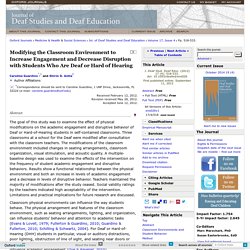
Revision received May 28, 2012. Accepted June 12, 2012. Classroom Arrangement. Teaching Mainstreamed Students with Hearing Loss, Zina Jawadi. Deafness, self-esteem, and the inclusive classroom. A deaf student surrounded by hearing peers in an inclusive classroom may experience feelings of isolation.

The classroom teacher, however, can play a critical role in supporting a deaf student’s self-esteem and sense of belonging within the culture of the classroom. Through expert interviews and classroom footage, this video discusses some of the factors that may contribute to a deaf student’s positive self-image. Modes of communication: Interpreters, hearing aids, and cochlear implants.
Understanding the variety of communication modes used by deaf people is critical in order for an inclusive classroom teacher to teach a deaf student effectively.
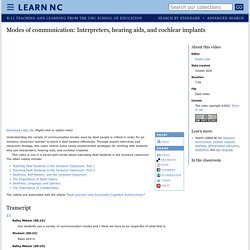
Through expert interviews and classroom footage, this video shares some easily-implemented strategies for working with students who use interpreters, hearing aids, and cochlear implants. This video is one in a seven-part series about educating deaf students in the inclusive classroom. The other videos include: The-Peer-Notetaker. True Life: Deaf Kids Shining Bright in High School.